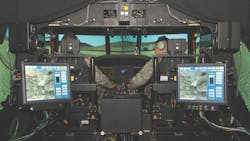Military researchers approach industry for 5G technologies for future deployable simulation and training
PICATINNY ARSENAL, N.J. – U.S. military researchers are asking for industry's help in developing enabling technologies in 5G communications to support realistic and deployable distributed simulation and training systems.
Officials of the U.S. Army Contracting Command at Picatinny Arsenal, N.J., issued a notice this week (W15QKN-20-Z-1AP2) for an upcoming request for prototypes for the 5G Augmented Reality/Virtual Reality Prototypes project.
The actual request for prototypes announcements is being handled through the National Spectrum Consortium in Summerville, S.C. Companies must be members of the consortium to participate in this project.
This initiative seeks to demonstrate how 5G communications technologies can support realistic distributed training and develop deployable equipment and systems to integrate these technologies into training operations.
Related: Deployable simulation and training
It is part of a larger military project develop and mature spectrum-access technologies to improve situational awareness of spectrum activity; project U.S. activity in the electromagnetic spectrum; and relocate and share spectrum anytime and anywhere access is necessary.
The Army Contracting Command issued this notice to industry on behalf of the Emerging Capabilities and Prototyping Office of the U.S. Office of the Deputy Assistant Secretary of Defense in the Pentagon.
Researchers want proposals that involve a 5G prototype testbed; 5G prototype enhancements; and 5G prototype applications. 5G is the next generation of mobile broadband communications with exponentially faster download and upload speeds, and drastically reduce the latency of wireless networks.
Distributed training includes information transmitted to the trainee via augmented reality and virtual reality protocols; ground instrumentation data; distributed simulation computing environments; command-and-control replicated data; and information transmitted from the trainee into the shared simulation environment.
Related: The increasing role of COTS in high-fidelity simulation
The National Spectrum Consortium is a research and development organization that incubates new technologies to revolutionize the way RF spectrum can used.
Companies interested should respond to this request for prototype projects no later than 30 April 2020. For more information on participating in this project, or becoming a member of the consortium, contact the National Spectrum Consortium online at www.nationalspectrumconsortium.org.
Email questions or concerns to Alexandria Trunzo at the Army Contracting Command, at [email protected].

John Keller | Editor-in-Chief
John Keller is the Editor-in-Chief, Military & Aerospace Electronics Magazine--provides extensive coverage and analysis of enabling electronics and optoelectronic technologies in military, space and commercial aviation applications. John has been a member of the Military & Aerospace Electronics staff since 1989 and chief editor since 1995.

